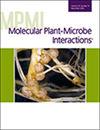Daniil M Prigozhin, Chandler A Sutherland, Sanjay Rangavajjhala, Ksenia V Krasileva
求助PDF
{"title":"玉米中大多数高度可变的 NLRs 具有相同的基因组位置,并含有额外的目标结合域。","authors":"Daniil M Prigozhin, Chandler A Sutherland, Sanjay Rangavajjhala, Ksenia V Krasileva","doi":"10.1094/MPMI-05-24-0047-FI","DOIUrl":null,"url":null,"abstract":"<p><p>Nucleotide-binding, leucine-rich repeat (LRR) proteins (NLRs) are a major class of immune receptors in plants. NLRs include both conserved and rapidly evolving members; however, their evolutionary trajectory in crops remains understudied. Availability of crop pan-genomes enables analysis of the recent events in the evolution of this highly complex gene family within domesticated species. Here, we investigated the NLR complement of 26 nested association mapping (NAM) founder lines of maize. We found that maize has just four main subfamilies containing rapidly evolving highly variable NLR (hvNLR) receptors. Curiously, three of these phylogenetically distinct hvNLR lineages are located in adjacent clusters on chromosome 10. Members of the same hvNLR clade show variable expression and methylation across lines and tissues, which is consistent with their rapid evolution. By combining sequence diversity analysis and AlphaFold2 computational structure prediction, we predicted ligand-binding sites in the hvNLRs. We also observed novel insertion domains in the LRR regions of two hvNLR subfamilies that likely contribute to target recognition. To make this analysis accessible, we created NLRCladeFinder, a Google Colaboratory notebook, that accepts any newly identified NLR sequence, places it in the evolutionary context of the maize pan-NLRome, and provides an updated clade alignment, phylogenetic tree, and sequence diversity information for the gene of interest. [Formula: see text] Copyright © 2024 The Author(s). This is an open access article distributed under the CC BY 4.0 International license.</p>","PeriodicalId":19009,"journal":{"name":"Molecular Plant-microbe Interactions","volume":" ","pages":"275-284"},"PeriodicalIF":3.4000,"publicationDate":"2025-03-01","publicationTypes":"Journal Article","fieldsOfStudy":null,"isOpenAccess":false,"openAccessPdf":"","citationCount":"0","resultStr":"{\"title\":\"Majority of the Highly Variable NLRs in Maize Share Genomic Location and Contain Additional Target-Binding Domains.\",\"authors\":\"Daniil M Prigozhin, Chandler A Sutherland, Sanjay Rangavajjhala, Ksenia V Krasileva\",\"doi\":\"10.1094/MPMI-05-24-0047-FI\",\"DOIUrl\":null,\"url\":null,\"abstract\":\"<p><p>Nucleotide-binding, leucine-rich repeat (LRR) proteins (NLRs) are a major class of immune receptors in plants. NLRs include both conserved and rapidly evolving members; however, their evolutionary trajectory in crops remains understudied. Availability of crop pan-genomes enables analysis of the recent events in the evolution of this highly complex gene family within domesticated species. Here, we investigated the NLR complement of 26 nested association mapping (NAM) founder lines of maize. We found that maize has just four main subfamilies containing rapidly evolving highly variable NLR (hvNLR) receptors. Curiously, three of these phylogenetically distinct hvNLR lineages are located in adjacent clusters on chromosome 10. Members of the same hvNLR clade show variable expression and methylation across lines and tissues, which is consistent with their rapid evolution. By combining sequence diversity analysis and AlphaFold2 computational structure prediction, we predicted ligand-binding sites in the hvNLRs. We also observed novel insertion domains in the LRR regions of two hvNLR subfamilies that likely contribute to target recognition. To make this analysis accessible, we created NLRCladeFinder, a Google Colaboratory notebook, that accepts any newly identified NLR sequence, places it in the evolutionary context of the maize pan-NLRome, and provides an updated clade alignment, phylogenetic tree, and sequence diversity information for the gene of interest. [Formula: see text] Copyright © 2024 The Author(s). This is an open access article distributed under the CC BY 4.0 International license.</p>\",\"PeriodicalId\":19009,\"journal\":{\"name\":\"Molecular Plant-microbe Interactions\",\"volume\":\" \",\"pages\":\"275-284\"},\"PeriodicalIF\":3.4000,\"publicationDate\":\"2025-03-01\",\"publicationTypes\":\"Journal Article\",\"fieldsOfStudy\":null,\"isOpenAccess\":false,\"openAccessPdf\":\"\",\"citationCount\":\"0\",\"resultStr\":null,\"platform\":\"Semanticscholar\",\"paperid\":null,\"PeriodicalName\":\"Molecular Plant-microbe Interactions\",\"FirstCategoryId\":\"99\",\"ListUrlMain\":\"https://doi.org/10.1094/MPMI-05-24-0047-FI\",\"RegionNum\":3,\"RegionCategory\":\"生物学\",\"ArticlePicture\":[],\"TitleCN\":null,\"AbstractTextCN\":null,\"PMCID\":null,\"EPubDate\":\"2024/11/23 0:00:00\",\"PubModel\":\"Epub\",\"JCR\":\"Q2\",\"JCRName\":\"BIOCHEMISTRY & MOLECULAR BIOLOGY\",\"Score\":null,\"Total\":0}","platform":"Semanticscholar","paperid":null,"PeriodicalName":"Molecular Plant-microbe Interactions","FirstCategoryId":"99","ListUrlMain":"https://doi.org/10.1094/MPMI-05-24-0047-FI","RegionNum":3,"RegionCategory":"生物学","ArticlePicture":[],"TitleCN":null,"AbstractTextCN":null,"PMCID":null,"EPubDate":"2024/11/23 0:00:00","PubModel":"Epub","JCR":"Q2","JCRName":"BIOCHEMISTRY & MOLECULAR BIOLOGY","Score":null,"Total":0}
引用次数: 0
引用
批量引用

 求助内容:
求助内容: 应助结果提醒方式:
应助结果提醒方式:


